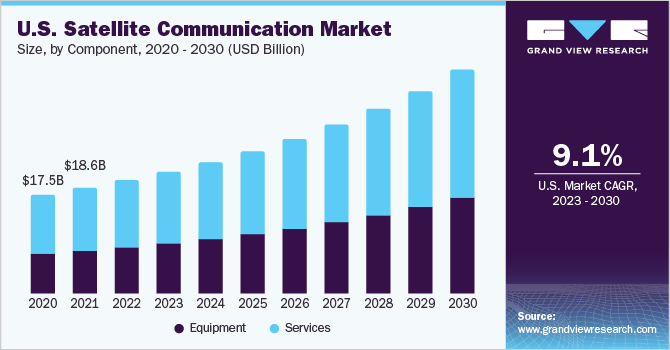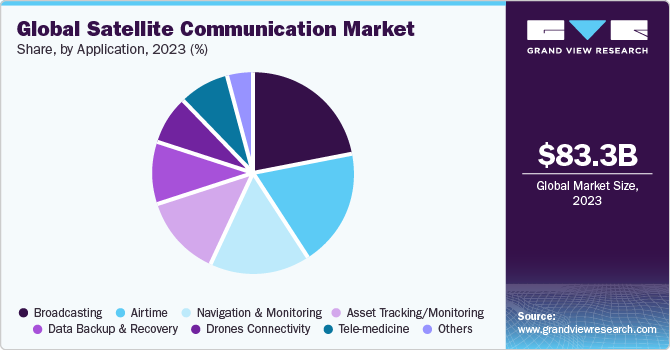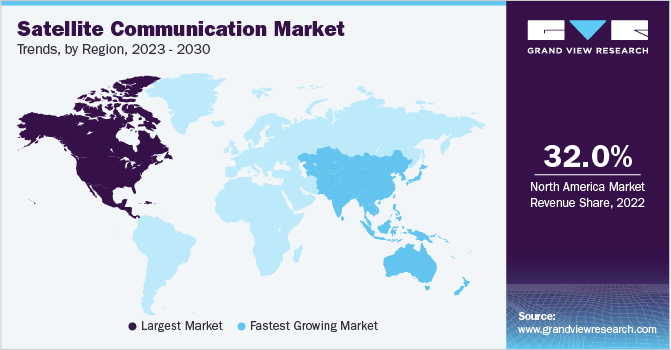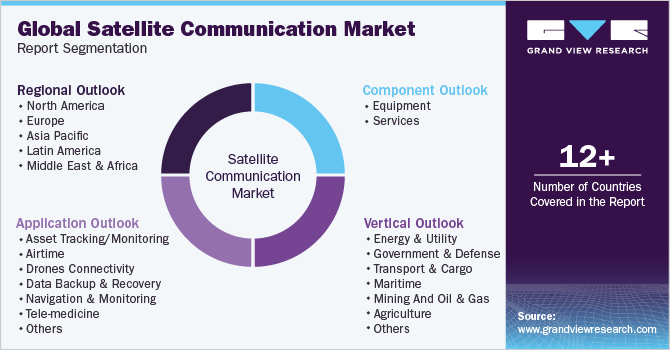- Home
- »
- Communications Infrastructure
- »
-
Satellite Communication (SATCOM) Market Size Report 2030GVR Report cover
![Satellite Communication (SATCOM) Market Size, Share & Trends Report]()
Satellite Communication (SATCOM) Market Size, Share & Trends Analysis Report By Component (Equipment, Services), By Application (Broadcasting, Airtime), By Vertical, By Region, And Segment Forecasts, 2023 - 2030
- Report ID: GVR-4-68038-975-3
- Number of Pages: 100
- Format: Electronic (PDF)
- Historical Range: 2017 - 2021
- Industry: Technology
Report Overview
The global satellite communication (SATCOM) market size was estimated at USD 77.08 billion in 2022 and is expected to grow at a compound annual growth rate (CAGR) of 9.7% from 2023 to 2030. The growth of the market can be attributed to the growing demand for High-throughput Satellite Systems (HTS), which provide significantly increased capacity and data speeds compared to traditional satellite systems. HTS enables faster and more efficient data transmission, making it ideal for bandwidth-intensive applications such as video streaming, remote sensing, and Internet of Things (IoT) connectivity.

At the same time, new frequency bands, such as high-frequency and very high-frequency bands, are expanding the available spectrum for satellite communication. These bands offer improved bandwidth and increased capacity, enabling higher data rates and supporting bandwidth-hungry applications.
Several satellite communication solution providers across the globe are focusing on developing solutions to offer better connectivity to a myriad of use cases. For instance, in June 2023, Get SAT, a provider of miniaturized satellite communication terminals, launched its latest product line, MoComm, featuring the innovative Multi Orbit Communication capability. This groundbreaking feature enables smooth and efficient switching between satellite constellations, ensuring uninterrupted connectivity.
MoComm operates seamlessly in both Ku and Ka-bands. The Ka-band functionality empowers users to seamlessly transfer data traffic between O3B Medium Earth Orbit (MEO) and any Geostationary Orbit (GEO) constellation. Additionally, the Ku-band has received certification for compatibility with LEO and any GEO constellation, further expanding its versatility and applicability.
Increasing use of satellite communications in the government & defense sector is also contributing to the growth of the market. Government sectors are actively transforming their operational environments, leading to an increasing dependence on sensor data and ISR platforms. These platforms facilitate the sharing of real-time HD video and other valuable information obtained from Remotely Piloted Air Systems (RPAS) or Unmanned Aerial Vehicles (UAVs). Consequently, the demand for HTS capacity continues to escalate for government and military applications. In addition, notable satellite communication service providers like Viasat, Inc. and SES S.A. are making significant investments to pioneer novel solutions tailored to various government and defense applications.
The increasing deployment of satellite constellations dedicated to IoT connectivity is also contributing to the growth of the market. These constellations consist of several small satellites working together to provide global coverage for IoT devices, enabling seamless communication and data exchange across vast geographic areas. This trend is driven by the growing demand for IoT applications in agriculture, logistics, environmental monitoring, and asset tracking sectors, where ubiquitous connectivity is essential.
Another emerging trend is the development of Low Earth Orbit (LEO) satellite networks specifically designed for IoT applications. LEO satellites offer advantages such as lower latency, improved signal strength, and higher data throughput, making them well-suited for IoT data transmission. These networks leverage advanced technologies like narrowband and low-power communication protocols to optimize IoT device connectivity, ensuring efficient utilization of satellite resources.
Furthermore, the satellite communication market is witnessing the adoption of advanced technologies like Artificial Intelligence (AI), which are driving the emergence of intelligent transport systems (ITS). These systems enable real-time vehicle tracking, facilitating the swift exchange of information for both users and freight operators. Satcom integration in transportation ensures continuous and seamless data transmission between vehicles and transport hubs, eliminating the reliance on terrestrial networks. As a result, the utilization of satellites in the transport and logistics network presents promising growth prospects for the satellite communication industry.
COVID-19 Impact Analysis
The COVID-19 pandemic has moderately impacted the Satellite Communication market. The coronavirus pandemic has had a devastating and multi-ranging impact on various industries and sectors. On the other hand, satellite communications facilitated uninterrupted communication for delivering content in remote areas during the coronavirus pandemic. At the same time, new product deliveries were slowed, thereby hampering the mission deployments. The subsequent supply chain disruptions and conducting operations with a reduced workforce at the industrial level subsided the growth of the overall satellite communications industry.
Component Insights
The services segment dominated the market in 2022 and accounted for more than 59.0% share of the global revenue. The segment growth can be attributed to the global expansion of the media and entertainment industries, coupled with the increasing demand for satellite television in emerging nations. Efforts to enable seamless data transmission to end-user locations also contribute to the growth.
However, the high upfront costs associated with satellite acquisition often make it financially challenging for many firms to purchase satellites outright. As a result, an increasing number of companies are opting for satellite services through leasing arrangements. Domestic direct-to-home (DTH) operators, for instance, are typically limited to using satellites ordered by their respective space agencies or leasing capacity from foreign satellites. Technological advancements play a crucial role in reducing the manufacturing costs of satellites, thereby lowering lease expenditure, and driving revenue growth in the market.
The equipment segment is projected to witness remarkable growth over the forecast period. The growth of this segment can be credited to the increasing need for uninterrupted communication in various industries, including energy and utilities, oil and gas, agriculture, defense, and the growing presence of connected and autonomous vehicles.
These industries rely on satellite communication systems for diverse applications such as telecommunications, navigation, weather monitoring, and surveillance systems, enabling effective communication with satellites orbiting the Earth. Moreover, the introduction of low earth orbit (LEO) satellites and satellite constellations for telecommunication purposes has led to a surge in the global demand for satellite equipment. These factors are expected to create promising opportunities for the growth of this segment throughout the forecast period.
Vertical Insights
The media & broadcasting segment dominated the market in 2022 and accounted for more than 15.0% share of the global revenue. The media & broadcasting segment can be considered one of the most significant segments that leverage satellite communication technology. Companies in this industry rely on satellite communication to transmit live news, sports events, concerts, and various other programs to their audience. This technology benefits consumers globally as satellites broadcast video channels that can be received by both broadcast networks and cable operators. In addition to broadcasting video channels, satellite communication offers other services, such as onsite live news reporting, satellite television, and satellite radio.
The government & defense segment is projected to grow at the highest CAGR over the forecast period. Increasing emphasis on secure and resilient satellite communication solutions to meet the evolving needs of government agencies and defense organizations is a significant factor contributing to the growth of the segment. This includes the adoption of advanced encryption techniques, anti-jamming capabilities, and robust cybersecurity measures to safeguard sensitive data and ensure uninterrupted communication in critical situations.
Secondly, there is a growing demand for satellite-based intelligence, surveillance, and reconnaissance (ISR) capabilities. Government and defense entities are leveraging satellite communication to gather real-time information, monitor remote areas, and enhance situational awareness. The integration of high-resolution imaging, video streaming, and advanced analytics technologies is enabling more effective ISR operations, facilitating rapid decision-making and response.
Application Insights
The broadcasting segment dominated the market in 2022 and accounted for more than 22.0% share of the global revenue. The expansion of the broadcasting sector has been influenced by the growing demand for satellite communications in pay-TV and radio applications. Direct-to-home (DTH) providers worldwide use satellite communication services to deliver services to customers and ensure seamless connectivity, even in remote and inaccessible areas.
The increasing consumer expectations for high-quality audio and video content have driven significant advancements in satellite communication equipment. The emergence of IP live-production technology has facilitated the production and transmission of Ultra-High Definition (UHD) and 4K content, enhancing the viewing experience. Furthermore, investments in the broadcasting and cable television industries, coupled with technological advancements and government incentives in emerging economies to transition to digital platforms, are significant factors contributing to the segment's growth.

The airtime segment is projected to witness significant growth over the forecast period. The rising demand for reliable and affordable communication services for flights and aircraft is fueling the growth of the segment. Additionally, the growing utilization of satellite communications for navigation purposes in aircraft is expected to further contribute to the segment's expansion.
Satellite communication solutions provide added value by offering seamless connectivity and high-speed internet access onboard aircraft, catering to the needs of both the crew and business applications. These solutions also support remote troubleshooting capabilities. Furthermore, satellite communication solutions enhance voice calls, enable accurate weather forecasting, and provide customizable dashboards that allow users to access real-time information on traffic for voice and data, along with associated costs.
Regional Insights
The North America region dominated the market in 2022 and accounted for more than 32.0% share of the global revenue. Growing demand for satellite broadband services, especially in remote and hard-to-reach areas, is anticipated to create lucrative growth opportunities for the segment over the forecast period. This trend presents significant revenue generation opportunities as satellite communication becomes essential for providing reliable connectivity in underserved regions of North America.
The North America region is also witnessing the emergence of key market players such as Viasat, Inc.; Intelsat; Telesat; and Harris Technologies, Inc. These companies are driving innovation and actively contributing to the growth of the satellite communication industry in North America. Their investments in research and development, advanced technologies, and strategic partnerships are fueling the expansion of the industry in the region.

The Asia Pacific region is projected to grow at the highest CAGR over the forecast period. The expansion of the satellite communication market in Asia Pacific can be attributed to the relentless pursuit of innovation, research and development, and strategic initiatives by prominent market players aiming to enhance their market presence. Furthermore, the increasing reliance on satellite communication-dependent services in sectors such as telecommunications, media and broadcasting, agriculture, and energy and utility within Asia Pacific is anticipated to be a significant driver of market growth. The region is home to numerous organizations dedicated to advancing satellite communications.
Key Companies & Market Share Insights
The satellite communication industry exhibits a significant level of fragmentation, with numerous players vying for market share and employing diverse strategies to stay competitive. More specifically, satellite operators are making substantial investments in the development of Ka-band applications, enabling faster transmission of critical data with minimal reliance on terrestrial infrastructure. These operators are also dedicated to ensuring competitive pricing to attract customers.
Additionally, market players are actively involved in forming partnerships, pursuing acquisitions, and engaging in mergers to strengthen their position and expand their offerings in the market. For instance, in May 2023, Arabsat, a global provider of broadcasting and telecommunication satellites, successfully launched Arabsat Badr-8 using a SpaceX Falcon 9 rocket launched from Cape Canaveral, Florida, USA. Badr-8 aims to offer advanced satellite services to customers and partners in the Middle East; Africa; Central Asia; and beyond.
Major players in the industry are making substantial investments in research and development (R&D) to broaden their range of products, thereby fostering the growth of the market. Additionally, market participants are actively expanding their global footprint through various strategic measures, including the introduction of new products, collaborations, mergers and acquisitions, and cooperative ventures. Some prominent players in the global satellite communication (SATCOM) market include:
-
Viasat, Inc.
-
SES S.A.
-
Intelsat
-
Telesat
-
EchoStar Corporation
-
L3Harris Technologies, Inc.
-
Thuraya Telecommunications Company
-
SKY Perfect JSAT Group
-
GILAT SATELLITE NETWORKS.
-
Cobham Limited
Satellite Communication (SATCOM) Market Report Scope
Report Attribute
Details
Market size value in 2023
USD 83.29 billion
Revenue forecast in 2030
USD 159.60 billion
Growth rate
CAGR of 9.7% from 2023 to 2030
Base year for estimation
2022
Historical data
2017 - 2021
Forecast period
2023 - 2030
Report update
July 2023
Quantitative units
Revenue in USD billion, CAGR from 2023 to 2030
Report coverage
Revenue forecast, company market share, competitive landscape, growth factors, and trends
Segments covered
Component, application, vertical, region
Regional scope
North America; Europe; Asia Pacific; Latin America; Middle East & Africa
Country scope
U.S.; Canada; U.K.; Germany; France; Italy; China; India; Japan; South Korea; Brazil; Mexico
Key companies profiled
Viasat, Inc.; SES S.A.; Intelsat; Telesat; EchoStar Corporation; L3Harris Technologies, Inc.; Thuraya Telecommunications Company; SKY Perfect JSAT Group; GILAT SATELLITE NETWORKS.; Cobham Limited
Customization scope
Free report customization (equivalent up to 8 analysts’ working days) with purchase. Addition or alteration to country, regional & segment scope.
Pricing and purchase options
Avail customized purchase options to meet your exact research needs. Explore purchase options
Global Satellite Communication (SATCOM) Market Report Segmentation
This report forecasts revenue growth and provides an analysis of the latest trends in each of the sub-segments from 2017 to 2030.For this study, Grand View Research has segmented the global satellite communication (SATCOM) market report based on component, application, vertical, and region:

-
Component Outlook (Revenue, USD Billion, 2017 - 2030)
-
Equipment
-
Satcom Transmitter/Transponder
-
Satcom Antenna
-
Satcom Transceiver
-
Satcom Receiver
-
Satcom Modem/Router
-
Others
-
-
Services
-
-
Application Outlook (Revenue, USD Billion, 2017 - 2030)
-
Asset Tracking/Monitoring
-
Airtime
-
M2M
-
Voice
-
Data
-
-
Drones Connectivity
-
Data Backup & Recovery
-
Navigation & Monitoring
-
Tele-medicine
-
Broadcasting
-
Others
-
-
Vertical Outlook (Revenue, USD Billion, 2017 - 2030)
-
Energy & Utility
-
Government & Defense
-
Government (Civil Uses)
-
Emergency Responders
-
Defense
-
-
Transport & Cargo
-
Fleet Management
-
Rail services
-
-
Maritime
-
Mining And Oil & Gas
-
Oil & Gas
-
Mining
-
-
Agriculture
-
Communication Companies
-
Corporates/Enterprises
-
Media & Broadcasting
-
Events
-
Aviation
-
Environmental & Monitoring
-
Forestry
-
End User - Consumer
-
Healthcare
-
Others
-
-
Regional Outlook (Revenue, USD Billion, 2017 - 2030)
-
North America
-
U.S.
-
Canada
-
-
Europe
-
U.K.
-
Germany
-
France
-
Italy
-
-
Asia Pacific
-
China
-
India
-
Japan
-
South Korea
-
-
Latin America
-
Brazil
-
Mexico
-
-
Middle East & Africa
-
Frequently Asked Questions About This Report
b. The global satellite communication (SATCOM) market size was estimated at USD 77.08 billion in 2022 and is expected to reach USD 83.29 billion in 2023.
b. The global satellite communication (SATCOM) market is expected to grow at a compound annual growth rate of 9.7% from 2023 to 2030 to reach USD 159.60 billion by 2030.
b. North America dominated the market for satellite communication and accounted for over 32.2% share in 2022.
b. Some key players operating in the SATCOM market include SES S.A.; Viasat, Inc.; Intelsat; Telesat; EchoStar Corporation; L3 Technologies, Inc.; Thuraya Telecommunications Company; SKY Perfect JSAT Group; GILAT SATELLITE NETWORKS; Cobham Limited.
b. Key factors that are driving the satellite communication market growth include the escalating demand for small satellites for earth observation services in various industries such as oil & gas, energy, agriculture, and defense and the increasing use of satellite communications by companies to collect operational data to improve efficiency and to realize sustainable ways of conducting business.
Share this report with your colleague or friend.
![gvr icn]()
NEED A CUSTOM REPORT?
We can customize every report - free of charge - including purchasing stand-alone sections or country-level reports, as well as offer affordable discounts for start-ups & universities. Contact us now
![Certified Icon]()
We are GDPR and CCPA compliant! Your transaction & personal information is safe and secure. For more details, please read our privacy policy.
We are committed towards customer satisfaction, and quality service.
"The quality of research they have done for us has been excellent."





